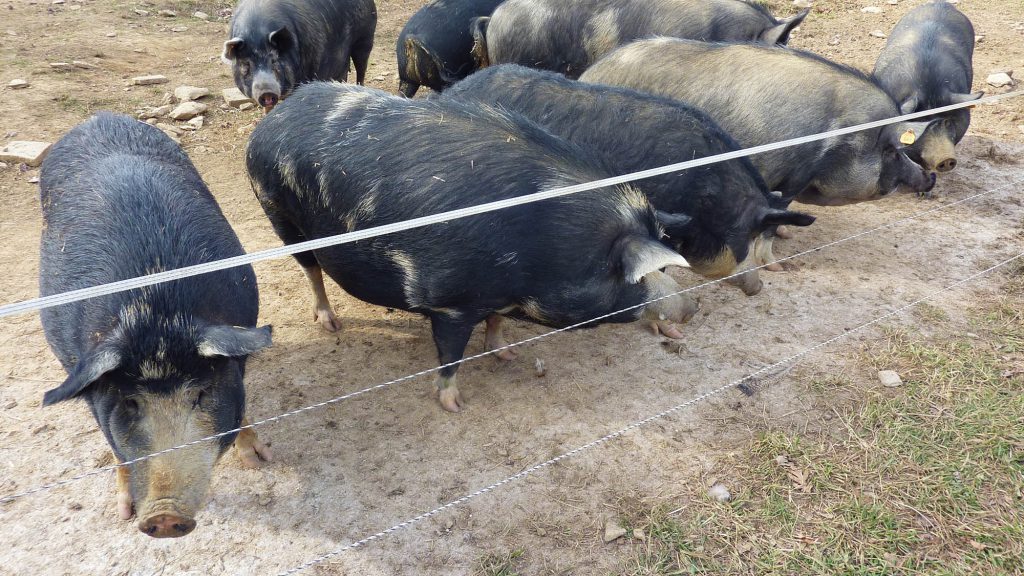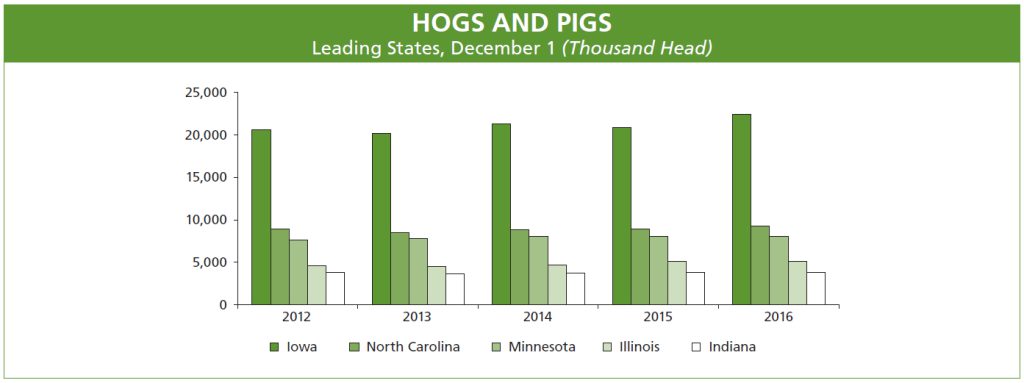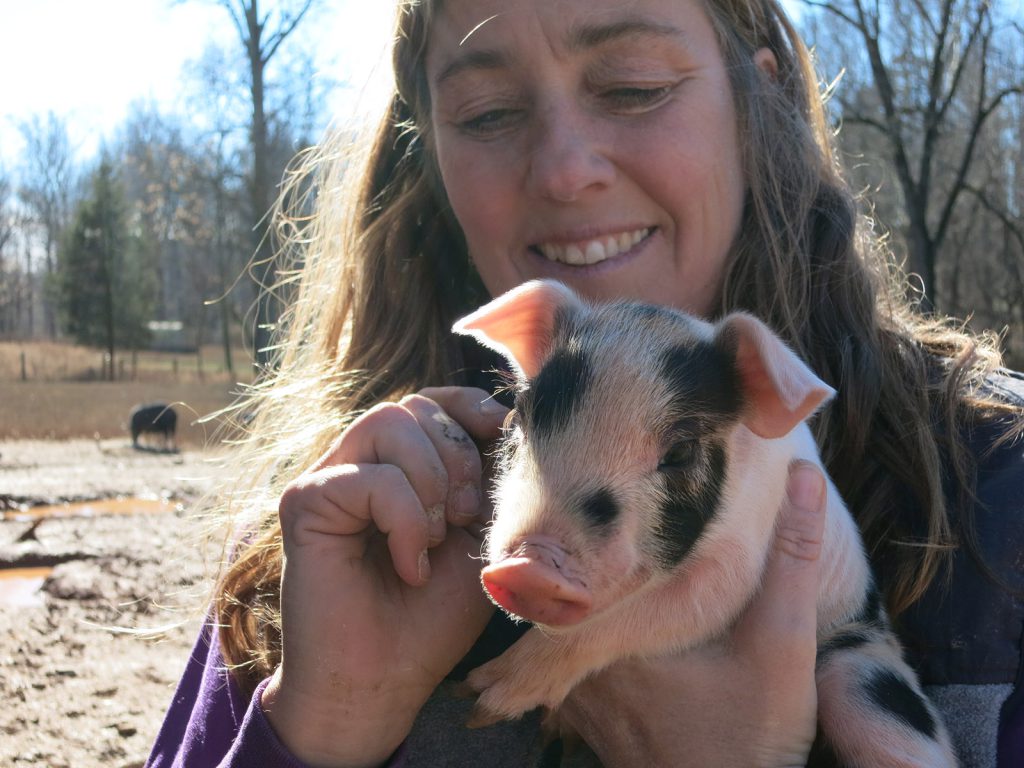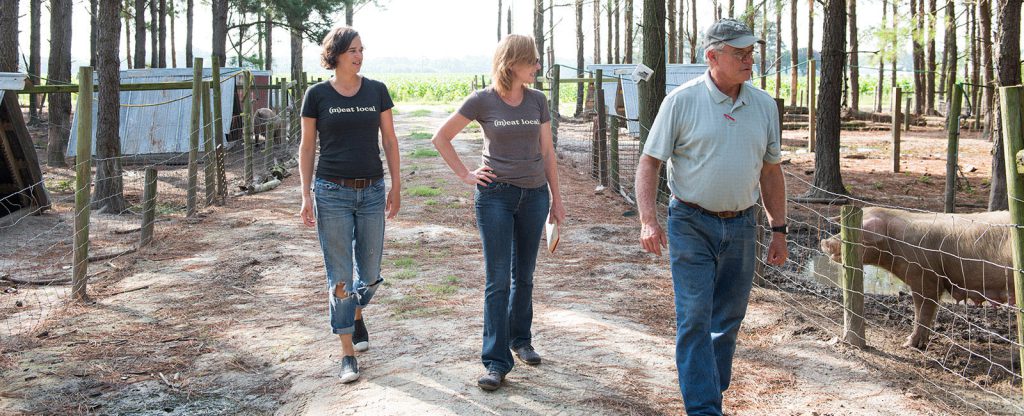The Dream of the Green Hog Revolution

This September, as Hurricane Florence bore down on the North Carolina coast, it spread a soup of stinking effluent from at least 110 lagoons on the state’s enormous pig farms over homes and towns, and left more than 5,500 dead hogs in its wake. It’s not the first time that such disaster has struck North Carolina. Hurricane Fran, which hit in early September 1996, caused US$7.2 billion in damages and killed 16,000 pigs. Hurricane Floyd, in September 1999, came straight through the heart of the eastern part of the state, where industrial livestock production is concentrated. Countless lagoons holding animal waste were breached, severely contaminating surrounding rivers. A hundred thousand North Carolina hogs drowned in the weeks that followed.
North Carolina, where I used to live and do my research, is at the heart of the United States’ pork production industry: According to the U.S. Department of Agriculture, it holds nearly 9 million farmed hogs, putting it second only to Iowa. This vast, industrialized system for the production of meat has long been controversial. While advocates say Concentrated Animal Feeding Operations (CAFOs) are the most efficient way to raise pigs for Americans, opponents note that the system is designed to maximize the profit of big business owners. And as those profits increase, small farmers go into debt, animal rights advocates continue to be appalled at the treatment of livestock, and vast amounts of waste accumulate in lagoons that spread their toxicity when accidents—or hurricanes—breach their walls. These industrial facilities, opponents argue, aren’t being held to account for their impacts. Instead, they benefit from policies that let them avoid paying for the full human and environmental costs of their practices.
Such problems have inspired some to look for alternatives. Livestock farmers, scholars of animal science, and environmental activists from across the state and region have come together to promote the production and marketing of “pasture-raised pork”—meat that comes from pigs raised outdoors on grassy pastures rather than in confinement.
Advocates for this pastured system describe it as sustainable. In contrast to CAFOs, it puts much less stress on the animals, uses their manure to enrich soils, and can avoid the unnecessary use of antibiotics. Pasture-based systems never lead to the buildup of toxic waste associated with hog lagoons, and the farm laborers’ working conditions are almost always better. The movement is now about 20 years old. No national agency keeps track of the numbers, but the best estimates suggest that about 5 percent of the pork sold in the U.S. is now produced this way, and it’s on the rise.
From 2008 to 2015, I conducted ethnographic research with farmers, chefs, agriculture officers, and customers at farmers markets, all of whom were interested in pasture-raised pork. I emerged from this work with a more nuanced view of both the benefits and challenges of the pasture-fed pork movement, as I wrote about in my 2016 book Real Pigs. I found a group of people deeply committed to combating some of the problems associated with the industrial system of food production, to establishing a connection between food producers and consumers, and to creating a flavorful, artisanal product. Yet I also found a system that, in spite of some serious efforts to the contrary, struggles to reach lower middle-class and working-class families. Select producers have learned how to successfully market their meat, but they still serve a fairly narrow range of mostly well-to-do consumers.
In almost every part of North Carolina, it is now possible to find farmers, often on smaller family farms, who are raising a handful or a few hundred pigs while also cultivating vegetables. They use pig manure as fertilizer, and the pigs do the labor of a good tractor in turning the soil. Often the farmers keep the meat for themselves or harvest a limited amount to sell. Those who sell their pork usually connect directly to consumers and restaurants—a practice called direct marketing. Sometimes this means they create relationships with restaurants that want to feature pasture-raised pork. In other cases, it involves making high-end artisanal products, such as smoky bacon or dry-aged prosciutto, that can be sold over the internet. Most often it means that farmers rely on farmers markets. As Charles “Doc” Sydnor of Braeburn Farms used to routinely tell the visitors on his farm tours, “We want to help our customers make that connection between their food and their farmers.” That sentiment is at the heart of direct marketing for food.
Along with these new methods of husbandry and marketing has come an increase in—or, as some would say, the revitalization of—more diverse breeds of pig. Industrial pigs are typically a proprietary cross of breeds engineered to produce long, lean hogs that have larger loins. These animals yield more profitable tenderloins and pork chops. Today The Livestock Conservancy recognizes 11 certified “heritage breeds” of pig—hogs that have a history in the U.S. but might now be endangered. “Heritage” adds another form of value to the mix of pasture-raised animals. Tamworth hogs are known for their flavorful bacon, for example, and Berkshires for their fat, well-marbled shoulders—and fat is where the flavor lies when it comes to pork. Some participants in this kind of livestock production see heritage breeds as a kind of gimmick, a marketing scheme designed to advertise to well-heeled consumers. But advocates for The Livestock Conservancy, and the farmers who work with them, feel that bringing back heritage breeds is a form of environmental activism: a way to promote biodiversity and match animals to the natural, social, and cultural ecologies in which they are raised.
Eliza MacLean of Cane Creek Farm in Saxapahaw, North Carolina, is renowned in the community of pasture-raised pork producers for her efforts to raise the Ossabaw Island hog, among a host of other heritage and hybridized pigs. The Ossabaw Island hog has a remarkable history. They were originally abandoned on Ossabaw, an island off the coast of Georgia, in the early 16th century by Spanish colonists. By 2000, the Georgia Department of Natural Resources decided to remove the “wily” feral pigs because they were destroying the nests of endangered loggerhead turtles. A small group of pigs was sent to the mainland to be researched as part of a National Institutes of Health study on diabetes, since these animals have a propensity to develop type 2 diabetes. This group was later taken to the swine husbandry program at North Carolina Agricultural and Technical State University, where MacLean was working as she began her pig farming operation. In part because of their adaptation to the limited resources of Ossabaw Island, Ossabaw hogs are short, extra-fat pigs. They grow slowly but thrive in exactly the kinds of marginal lands that are found throughout the rocky and hilly Carolina Piedmont. They love grazing in the detritus of old woods and relish the acorns and hickory nuts that dot the forest floors of central North Carolina.
Although farmers like MacLean have found some limited economic success, the emerging system faces challenges in its attempts to gain a larger footing in the market. Perhaps the biggest impediment to growth is the limited number of slaughterhouse facilities across the country. The pig industry is now dominated by massive-scale facilities whose owners are prohibited, by their contracts with industrial farmers, from working with smaller customers, like farmers raising their pigs on pasture. If farmers want to slaughter their own animals, that’s fine—and some farmers and families do just that. But they cannot sell any meat produced in this way; all pork sold in the U.S. must be processed in a USDA-approved facility. The number of independent facilities willing to do work for small-scale farmers has declined dramatically in the last two decades.
For now, pasture-raised pork is generally more expensive than the industrialized product. For example, specialty bacon at a farmers market in Chapel Hill in 2018 costs about US$12 per pound, but at a nearby Food Lion grocery store, I can purchase a pound of Smithfield Bacon for half that price. In addition, pasture-raised pork is only available in limited places. When I lived in North Carolina, it was relatively easy to purchase my pork at farmers markets, but when I moved to Virginia, that was no longer an easy option. Many small-volume farmers also don’t have the connections, skills, or time to viably market their products.
Some activists and entrepreneurs in North Carolina are looking for ways to overcome these limitations: creating more farmers markets, for example, or pushing for certification systems to give consumers the resources to recognize food created in more sustainable ways. Others work by aggregating multiple small producers into “food hubs.” The Durham-based company Firsthand Foods, for example, began operations in 2010. After many years working in and outside of university settings as an advocate for food safety and environmental protections, Jennifer Curtis and her business partner, Tina Prevatte, developed Firsthand Foods to reach out to small livestock farmers across central and eastern North Carolina. Many of these farmers raise livestock simply to provide manure and labor for their vegetable business, and they might barbecue a hog once or twice a year for their neighbors. Firsthand Foods purchases fully grown animals from farms dispersed across this region and processes, packages, markets, and brands the meat.
This business and others like it face pretty stiff financial pressures. Many depend on grants from universities and government agencies looking to promote small-scale agriculture. But they have been able to create markets for at least some farmers who might otherwise not be able to continue to raise their animals in sustainable ways.
It is hard to imagine pasture-raised animals providing meat for more than a small percentage of middle- and upper-class families in the U.S. And ramping up this alternative system cannot be a solution to all the problems associated with meat production anyway: It still takes much more land and energy to produce a given number of food calories as meat than as vegetables. (By some reports, it takes nearly twice as much grain to sustain a meat-based diet as compared to a vegetarian one.) Some people have ethical concerns with killing animals no matter how they were raised. It is clear, though, that pasture-raised animal systems can prevent the kinds of environmental damage to waterways and air quality associated with high-density confinement operations.
Perhaps the ultimate solution to these problems is for all of us to simply eat less meat—even some pasture-raised pork farmers suggest this to their customers. But a lot of the people I worked with note that many of the problems associated with meat production might be alleviated if industrial farmers were subject to stricter regulations and if the system as a whole was held financially accountable for the problems caused when something like a hurricane strikes. That would surely drive the price of industrially produced meat up, reducing consumption and making pork from smaller, pasture-fed operations more competitive. The future of hog farming is sure to be an engaging discussion for generations to come, and North Carolina farmers raising their pigs on pastures will undoubtedly be a part of that conversation.




































